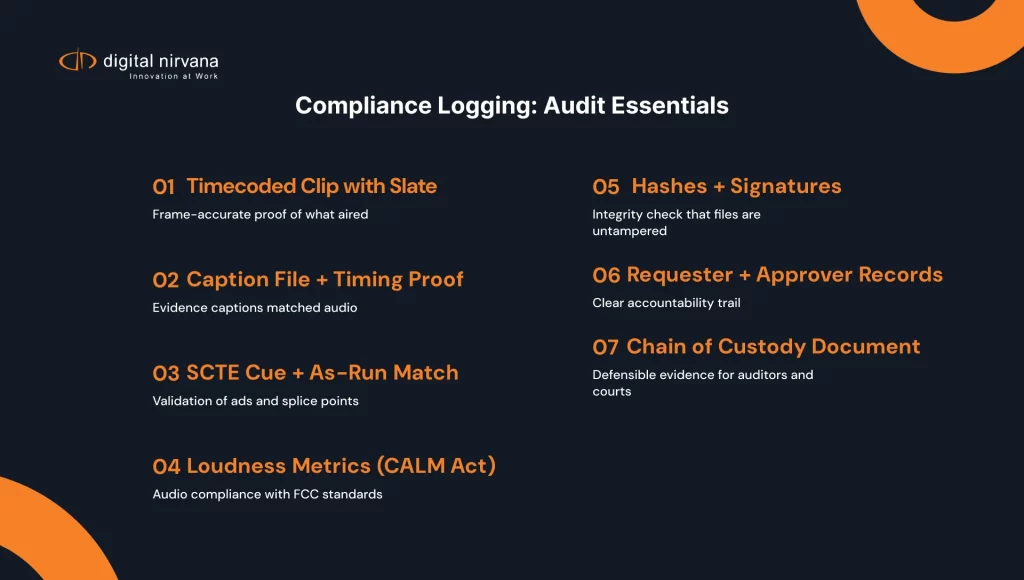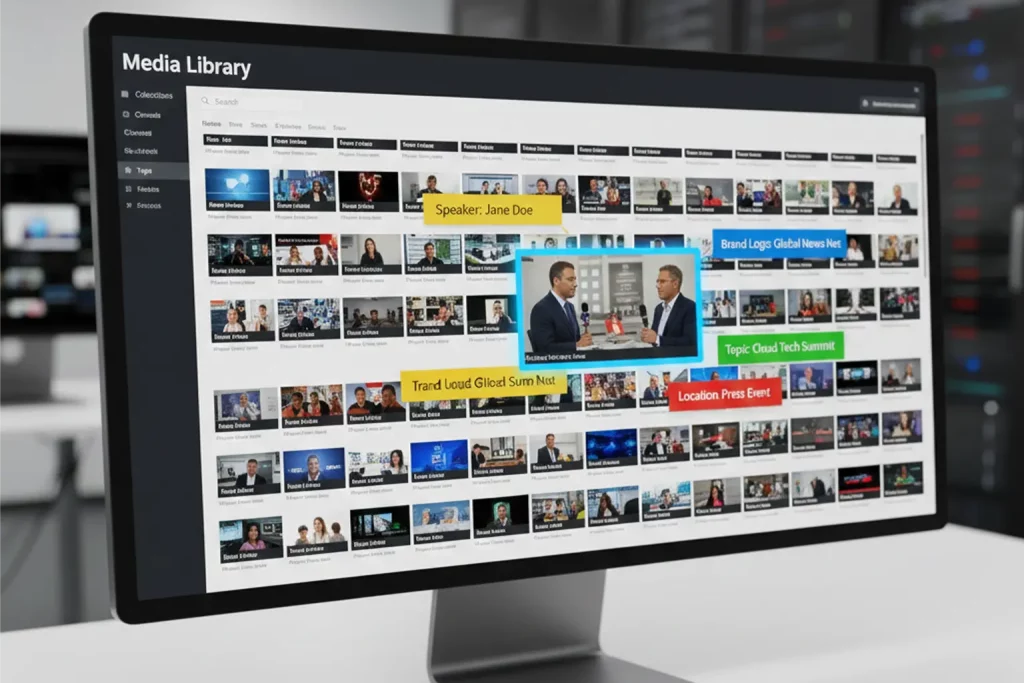Crisis clips, loudness proof, caption audit trails, and clean Audit Log Records now decide disputes in minutes. Stations that record every feed, index every second, and surface the right moment on demand reduce fines, speed makegoods, and defend trust. AI turns raw airchecks plus Security Logs, System Logs, and Search Logs into searchable evidence that legal, ad ops, and news can use. Automation routes Security Alerts and assembles reports while humans approve exports. Broadcasters that expand logging into monitoring win faster because they keep facts, Audit Records, and Accountability at their fingertips.

Compliance logging vs. broadcast compliance monitoring
Compliance logging captures, stores, and indexes air with timecodes for later proof and review. Broadcast compliance monitoring watches signals as they happen, raises alerts, and drives quick remediation. Logging answers what happened with evidence in the Activity Log and Audit Log. Monitoring answers what happens now with thresholds, tickets, and alert routing. A blended stack links live alerts to archived proof through common timecodes, User ID, Device ID, and IP Address metadata.
Our services at Digital Nirvana for AI‑first compliance
Our services at Digital Nirvana help teams produce defensible evidence without extra effort. With MonitorIQ compliance logging and monitoring, engineers capture multi‑channel feeds, analyze loudness, and export audit‑ready clips that hold up during Compliance Audits. MetadataIQ enriches archives with AI metadata so Log Analysis and Query work across entities, programs, and time ranges. TranceIQ delivers accurate transcripts and captions that support Regulatory Compliance and reduce Non‑Compliance risk during reviews. For end‑to‑end workflows, our Media & Broadcasting AI solutions connect the archive to newsroom, MAM, PAM, and NLE tools so reviewers, ad ops, and counsel move faster. We design for Immutability, documentation, and Administrator Audit Logging so Accountability stays clear.
Define the scope for U.S. TV, radio, OTT, and FAST
Scope drives coverage, retention, and budget. U.S. TV needs 24/7 capture for OTA, cable, and subchannels that reach a market. Radio needs logging for on‑air programming and any digital stream that mirrors or diverges from broadcast. OTT and FAST add app variants, ABR ladders, ad pods, and regional rules per device. A shared scope sheet lists data sources and configurations so teams avoid surprises when counsel requests proof.
What to include in scope
List every linear channel, multicast variant, and studio return that requires capture. Identify all OTT apps, CTV platforms, SharePoint or CloudCM exports, and SFTP handoffs. Map headends, transmitters, cloud playout, and data center points so capture mirrors real viewing paths. Define retention by market and license class and align with GDPR, HIPAA (often written as HIPPA in audit notes), and other Regulatory Compliance needs. Assign owners for Policy Updates so the scope stays current.
Where logging ends and live monitoring begins
Logging focuses on capture, search, and export. Monitoring focuses on thresholds, alerting, and resolution. Teams share metadata so a live alert links to a log segment with context and evidence. Engineers pivot from an alert to the exact aircheck and attach Audit Trail notes inside the archive. Legal trusts the process because clocks, hashes, and Admin Audit Log entries tie alerts to archived proof.

Touchpoints that connect both worlds
Use one timebase and NTP discipline so clips and alerts align frame by frame. Write alerts into the archive as annotations that include User Email, Sender, and Administrator Audit Logging fields. Let monitoring open tickets that include deep links to the logged segment and a Security Audit Log snippet. Feed resolution notes back into the archive so the record shows root cause, actions, and approvals. Build dashboards that show live status and searchable proof so leaders see the same story.
Why the overlap matters to legal and ad ops
Legal needs exportable evidence with verifiable timestamps and preserved quality to answer claims. Ad ops needs fast proof of playout and makegood decisions that protect margin. Shared metadata and clip templates shorten response times and prevent inconsistent answers. When logging and monitoring share a Log Management System and consistent audit trail, disputes close sooner. The station documents every Audit Process step so auditors accept results.
Common cross‑team scenarios
A sponsor challenges an ad run and wants affidavits and clips within the hour. An advocacy group files a caption complaint, and counsel requests caption accuracy logs, Search Logs, and timing proof. A regulator requests CALM Act loudness data for a window after viewer reports. A league asks for blackout enforcement proof across specific zip codes and entities. A newsroom leader asks for a sensitive clip for legal review before publishing online.
The U.S. rules that drive compliance logging
Rules set minimums that shape architecture, staffing, and evidence standards. Broadcasters must show loudness control, accurate and timely captions, proper emergency carriage, and sponsorship ID. They must honor blackout and regionalization agreements and document any variances. Strong log management for compliance makes these proofs quick to assemble and hard to dispute. Clean Audit Log Records tie dates, times, and approvers to the final clip.
CALM Act loudness standards you must track
Track integrated loudness, short‑term windows, and true peak to catch chronic and burst issues. Fire alerts when levels drift outside tolerance and keep records that show dialnorm and timecodes. Include who corrected levels, when, and how, and attach Audit Record links to the incident. Trend loudness by show and daypart to stop repeat problems and reduce fines. For authoritative background, see the FCC CALM Act page.
(Reference: FCC overview of the CALM Act and loud commercials — linked later in this section.)
Closed caption compliance and accessibility records
Keep evidence that captions existed, matched content, and met timing and placement goals. Store caption files, confidence scores, drift metrics, and reviewer notes in the archive. Tie fixes to timecodes so clips, transcripts, and tickets tell one coherent story. Track non‑program material where errors spike, including promos and graphics. Link to official guidelines so reviewers can cite rules during responses, including the FCC Closed Captioning rules and our explainer, Caption Rules for TV & Streaming: FCC Guidelines.
Emergency alerts, indecency, and children’s rules
Capture proper carriage of EAS with required crawl and audio. Store clips for any tone misuse and document prompt correction and staff training. Review language, scheduling, and separation rules to protect children’s programming windows. Document safe harbor practices and escalation paths for borderline content. Keep Audit Activity linked to responsible roles and approvals.
Political ad disclosures and sponsorship ID
Track who paid for each message and how the station identified the sponsor on air. Link copy, supers, and audio IDs to affidavits so reviewers confirm compliance quickly. Retain records by election cycle and market so retrieval stays simple. Capture makegoods and late changes and tie them to the right contracts and Case ID. Evidence supports fairness claims and keeps filings accurate.
AI raises the bar for broadcast compliance monitoring
AI expands what you see in real time and what you can prove without manual effort. Models convert speech to searchable text, identify logos and faces, and classify content. Engines parse SCTE signals and match ad playout to schedules for instant confidence. Smart alert design reduces noise so teams fix what matters and ignore the rest. Results include faster detection, cleaner evidence, and fewer disputes. For a deeper dive, read our blog on real‑time compliance monitoring.
(Internal resource: Digital Nirvana blog on real‑time compliance monitoring — linked within this section.)
Real‑time speech‑to‑text for searchable airchecks
ASR transcribes live audio with timecodes so staff can search by word, phrase, or name. Legal jumps to a quote, exports the clip, and includes context without guesswork. News verifies statements before publication and avoids misquotes. Ad ops confirms copy aired as sold and escalates only when words deviate. Accurate transcripts cut review time and lower risk.
Logo, face, and profanity detection with context
Vision models flag required bugs, competitor marks, and missing sponsorship slates. Systems detect profanity and slurs and tag the timeline for quick review. Face detection helps confirm talent usage rights and embargoes. Context windows show what surrounded the moment so reviewers judge intent and impact. Teams close tickets faster because evidence sits one click away.
Ad detection, SCTE 35 cues, and proof of playout
Engines match creative to reference fingerprints and confirm start and end with frame accuracy. Systems validate SCTE 35 insertion messages and track any missed or mistimed cue. Ad ops sees proof of performance in minutes and sends clean affidavits the same day. Sales protects revenue because makegoods rely on facts. Disputes drop when every claim includes timecodes and clean clips.
Less noise: smarter alerts and auto‑triage
Design alerts that rank by impact and confidence and route by on‑call and skill. Suppress repeat non‑issues while still logging them for trend review. Highlight open cases, aging items, and hotspots so leaders allocate resources. When alerts respect people’s time, resolution speeds up. Precision frees capacity for work that matters.
Design an AI‑ready compliance stack
Future‑proof operations with capture, metadata, storage, and integration that scale. Start with reliable 24/7 recording and attach rich, structured timecoded data. Use tiered cloud storage so you meet retention rules without bloat. Connect the archive to newsroom, MAM, PAM, and NLE tools so teams act without exports. Keep APIs open so you can add new models without ripping out the core. For practical setup guidance, see our blog on broadcast audio logging for compliance.
Multi‑channel capture and time‑coded archives
Record primary, backup, and return feeds so investigations never stall. Normalize container formats, timebase, and checksum policy to preserve integrity. Capture captions, SCTE, loudness, and Search Logs in parallel tracks. Validate completeness daily so gaps never surprise counsel. Keep immutable originals and watermarked derivatives for release.
Metadata enrichment that reads like a timeline
Attach words, faces, logos, locations, and compliance events as ordered entries. Use consistent taxonomies for entity names, program IDs, and ID Numbers. Include who reviewed, what changed, and why, so the record tells a complete story. Let users pin highlights and disputes so future reviewers land on the right moments. For hands‑on tips, review our AI metadata tagging guide.
Cloud storage, retention, and tiered costs
Place hot content on fast tiers, age routine airchecks down, and archive long‑retain markets cheaply. Align retention with FCC rules, consent decrees, contracts, and the Compliance Framework you follow. Encrypt at rest and in transit and rotate keys on a schedule that auditors accept. Run periodic restores to prove the plan works. Track cost per retained hour and optimize tiers.
APIs into MAM, PAM, newsroom, and NLE tools
Expose search, clip, and export functions so teams work inside their tools. Let newsroom systems request clips by slug and timecode and receive approved slates. Allow PAM and MAM to reference archive IDs instead of duplicating media. Give NLE users frame‑accurate pulls for quick assemblies. Solid APIs remove swivel‑chair work.
Audit Trail Logging Best Practices
An audit trail ties every action to a person, place, and time across your Log Management System. Capture User ID, Device ID, IP Address, User Email, Authentication Permission, and Administrator Audit Logging data on every change. Track Admin Audit Log entries for Configurations, Policy Updates, and Data Access Credentials. Keep Audit Logging Software tuned for Optimization so DevOps can handle Workload spikes without gaps. Align Audit Trail Best Practices with your Compliance Program and the Compliance Requirements that apply in your Geographies.
Database Audit Logging
Log reads, writes, deletes, and schema changes on compliance data stores with a unique Case ID. Include Query text, row counts, and affected Entity keys so Forensics can rebuild the sequence. Store Compliance Audit Logs with Immutability controls and prove chain of custody end to end. Mirror critical tables to a Logging Tool that writes to append‑only storage. Review hot paths weekly and document exceptions.
Security Audit Logging
Collect Security Logs from playout, encoders, CDN edges, OS events, and identity providers. Centralize into a Log Management System that supports Compliance Audits and real‑time Security Alerts. Tag events with Spectrum, channel, or Folder context so responders know scope. Integrate Datadog or similar Log Management Tools as part of a Log Monitoring System that correlates anomalies with on‑air evidence. Maintain a Security Audit Log view for auditors and a responder view for operations.
Audit Logging Best Practices
Define what to log, how long to retain, who can see it, and how to export it for Compliance Audits. Capture Auditing Events for logins, permission changes, SFTP transfers, SharePoint syncs, and CloudCM updates. Keep Administrator Audit Logging separate from user content logs to protect privacy. Test export formats against counsel’s Documentation needs. Train an Audit Admin to own the Audit Process and approve releases.
Audit Log Best Practices
Index by channel, program, timeframe, and Entity so retrieval stays simple. Use case‑based tags like political, EAS, caption, and loudness to group related items. Align fields with Regulatory Compliance frameworks such as HIPAA, GDPR, and PCI for Payment Data. Measure false positive rate across audit filters and tune rules quarterly. Publish a short guide that staff can follow during incidents.
Security Audit Log
Keep a dedicated, tamper‑evident stream for Authentication, MFA, and role changes. Tie events to Device ID and IP Address and link to user records and Email. Alert on Non‑Compliance patterns like failed exports, unusual Geographies, and off‑hours access. Route high‑severity items to legal when they involve regulated Data Sources. Store signed snapshots before and after major changes.
From linear to streaming: monitor everywhere viewers watch
Viewers move across platforms, so compliance must follow without gaps. Linear demands OTA and cable coverage. Apps demand ABR awareness and device nuance. FAST introduces dynamic ad decisions and pop‑up channels that change footprints daily. Regionalization and blackout rules add local constraints that you must honor across Entities.
OTA and cable headends
Monitor RF and IP feeds at plant exit and at headends. Capture off‑air checks to see what viewers receive in each market. Track PSIP, captions, and loudness at both points so you catch errors before and after distribution. Log weather crawls and EAS at local insertion points to meet obligations. Keep a map of handoffs so responsibility stays clear.
OTT and CTV apps with ABR ladders
Record all renditions because violations often appear at a specific bitrate or device. Validate captions, loudness, and ad markers at each rung of the ladder. Track player analytics and Usage Data alongside airchecks to tie complaints to evidence. Confirm CDN, DRM, and regional block behavior matches policy. Treat app updates as scope changes and re‑verify checks after each release.
FAST channels and dynamic ad insertion
Log the intended playout and the stream viewers received. Verify SCTE markers, ad pod structure, and competitive separation. Confirm brand safety and profanity filters across libraries and live events. Store proof for pop‑up channels that run during tentpole events. Give partners dashboard access for self‑serve affidavits.
Regionalization and blackout rules
Capture streams as delivered to protected zones and compare against rights maps. Alert when a flagged program appears in a blocked geography. Keep audit trails that show when you switched feeds and who approved exceptions. Coordinate with MVPDs and app partners so blackouts stay consistent. Clear proof protects relationships with leagues and studios.
Security and governance you can prove
Auditors and courts expect controls that protect media, metadata, and identities. Define who can view, tag, export, and delete, and log those actions. Secure at rest and in transit and verify integrity on export. Show consistent retention and defensible disposal that follows written policy. Governance builds trust and keeps your stack deployable in regulated environments.
SOC 2 controls, encryption, and access logs
Operate under an established control set and make roles and permissions explicit. Encrypt every object and rotate keys under a managed lifecycle. Write immutable access logs and monitor anomalies tied to data sensitivity. Limit elevated roles and require MFA for exports and admin actions. Provide auditors with control matrices and evidence packets that match their checklists.
Chain of custody and tamper‑evident exports
Compute hashes on ingest and preserve them through every transform to prove integrity. Burn timecode, channel ID, and watermark into exports and ship sidecar metadata. Sign exports and store signatures so third parties can verify authenticity. Track who requested each clip, who approved it, and who received it. Courts and partners accept evidence faster when you remove doubt.
Retention by market and license class
Tie retention windows to market size, network affiliation, and any consent decree. Automate tier moves and final deletion with approvals and logs. Hold litigation and regulatory notices pause deletion across defined scopes. Keep dashboards that show what you retain and why across Geographies. Good hygiene cuts cost and risk.
Human in the loop keeps AI accountable
AI accelerates review, but people still set standards, judge nuance, and approve exports. Define who reviews alerts, what accuracy targets apply, and when models need retraining. Build gates that block sensitive releases until a qualified person signs off. Capture reviewer notes with timecodes so future audits see the same context. Human judgment keeps quality high and errors rare.
Reviewer workflows and quality gates
Create queues by severity, channel, and rule. Require dual approval on legal clips and political ads. Add checklists for caption timing, loudness proof, and ID placement. Track throughput and accuracy so you can coach and rebalance. Publish SLAs so partners know what to expect.
Bias checks, accuracy targets, and audit trails
Measure ASR and vision accuracy on local accents and content types. Review false positives and misses and send curated sets back for retraining. Set floor targets for release and quarantine output that falls short. Keep a living model card that documents inputs, limits, and change history. Strong governance builds confidence in AI‑assisted evidence.
Redaction and privacy for sensitive content
Enable fast blur and bleep tools so teams can share clips without exposing PII. Mask minors, victims, and protected health information when law and policy require it. Store original and redacted versions with links and permissions. Document why you redacted and who approved it. Privacy‑respecting processes protect people and credibility.
KPIs that show compliance value
Leaders invest when teams show clear, comparable numbers. Track speed, precision, volume, and cost to tell a complete story. Publish reports that map improvement to risk reduction and revenue protection. Compare channels and dayparts to find hotspots. Use KPIs to prioritize projects that move the needle.
Mean time to detect and resolve violations
Measure time from incident start to alert, alert to ticket, and ticket to close. Trend by rule type and channel to target better monitoring or training. Tie faster resolution to fewer complaints and lower exposure. Share wins across teams to reinforce good practices. Fast detection proves your monitoring works.
Clip turnaround for legal and PR requests
Record time from request to export and track acceptance rate on first submission. Shorten cycles with templates and pre‑cleared affidavit language. Flag outliers and study root causes to remove friction. Show how faster clips close disputes sooner and protect brand reputation. Speed plus accuracy earns trust.
False positive rate and alert precision
Track noise ratio and investigate rules that waste time. Improve thresholds and context windows to raise confidence without misses. Share precision metrics so everyone sees the impact. Retire low‑value alerts and invest in models that deliver wins. Precision frees capacity for higher‑value work.
Cost per channel and per incident
Allocate storage, compute, and labor to each channel so budgets reflect reality. Track incident volume and handling time to reveal where automation helps. Compare spend before and after model tuning and workflow changes. Use savings to fund streaming expansion. Finance backs plans that show control and growth.
Implementation roadmap for U.S. broadcasters
A phased plan reduces risk and proves value at each step. Start with inventory and baselines, add AI where it pays back, then automate reports and escalation. Involve legal, engineering, ad ops, and news so you design for real users. Keep change control tight and document every policy and mapping. Expand into streaming once linear runs smoothly.
Phase 1: inventory feeds and obligations
List channels, returns, and app endpoints and map them to capture points. Document FCC obligations, Regulatory Compliance needs, and partner contract windows. Identify current tools and gaps, including Log Management Tools and Audit Logging Software. Create a single scope sheet that owners maintain after launch. Secure leadership sign‑off so resources match the plan.
Phase 2: capture, index, and baseline alerts
Deploy 24/7 recording and confirm NTP and timecode integrity. Index audio, captions, SCTE, loudness, Security Logs, and System Logs into a searchable archive. Stand up initial alerts for loudness, captions, black frames, and Authentication anomalies. Build export templates for legal and ad ops and test acceptance.
As‑run and SCTE alignment
Ingest as‑run logs and compare them to detections to find schedule gaps. Align SCTE cue timing with ad detection to reveal insertion defects. Share variance reports with traffic and playout for tuning. Annotate the archive with confirmed fixes. Prove progress with trend charts.
CALM Act loudness targets
Set target ranges per channel and content type, including promos and interstitials. Alert when integrated or short‑term measurements drift outside tolerance. Document corrections and keep before and after clips in the archive. Review daypart trends and fix root causes in acquisition or playout. Publish monthly summaries that show improvement, and consult the FCC’s CALM resources for policy clarity.
Phase 3: enrich with AI and integrate logs
Add ASR, logo, face, profanity, and anomaly models and route alerts by role. Expose archive search and clip functions inside newsroom, MAM, PAM, and NLE. Train reviewers on new queues and codify approval rules for sensitive exports.
ASR accuracy thresholds
Measure word error rate by program type and accent and set release floors. Quarantine segments that fall short and request human review. Send corrected transcripts back for retraining. Track gains to support investment. Use better transcripts to speed legal and news workflows.
Logo and profanity model tuning
Collect false positives and misses and label them with clear reasons. Adjust thresholds and context and add new classes for local brands and slurs. Validate changes against a holdout set before production. Document versions and dates. Publish results so teams trust the improvements.
Phase 4: automate reports and escalate smartly
Generate weekly and monthly reports for legal, engineering, and sales with no manual work. Add routing rules that escalate by severity, advertiser, and deadline. Provide partners with secure portals where they can pull proof.
Alert fatigue controls and routing
Group related events and cap bursty alerts into a single case with a timeline. Route by on‑call schedule and expertise so issues land with the right person. Track alert volume per user and adjust rules that overload teams. Healthy routing preserves focus and outcomes.
Audit‑ready clip templates
Pre‑bake watermark, slate, and affidavit language that counsel approves. Include source channel, timecodes, hashes, and signed sidecars. Offer redaction presets for minors and medical details. Track template versions and usage for review. Templates shrink turnaround and reduce errors.
Phase 5: review KPIs and expand to streaming
Compare KPI baselines to current performance and present wins and gaps. Add OTT, CTV, and FAST once linear hits targets. Consolidate dashboards across teams to remove duplicate effort.
Add OTT, CTV, and FAST footprints
Extend capture to app endpoints and ABR rungs and test per device class. Validate captions, loudness, and SCTE cues across each ladder. Bring partner logs into your archive so proof stays centralized. Share clean proofs with networks, leagues, and platforms. Streaming deserves the same rigor as linear.
Consolidate dashboards across teams
Unify legal, engineering, sales, and news views on a shared data model. Standardize KPIs so leaders can compare channels and markets. Retire duplicative tools and reduce swivel‑chair work. Expose self‑serve search with guardrails for sensitive content. One view improves decisions and speed.
Use cases across the station
Engineering, legal, sales, and news all win when one stack powers many jobs with clean evidence. Engineering needs root cause analysis with clear timelines. Legal needs clips and affidavits that third parties accept. Ad sales and traffic need proof of performance and fair makegoods. News and programming need archives that answer questions and fuel digital.
Engineering: signal, loudness, captions, metadata
Diagnose black, silence, dropouts, and drift with timeline evidence. Loudness trends reveal failing gear or bad ingest that needs fixes. Caption checks surface format mismatches and encoder quirks. Metadata visibility helps debug SCTE and ID bugs faster. Evidence speeds repair and reduces repeat incidents.
Legal and standards: airchecks and affidavits
Counsel asks for clips and receives export‑ready files with hashes and slates. Standards staff search transcripts and find moments with context in seconds. The team meets deadlines for regulators and adversaries with confidence. Acceptance improves because every packet includes consistent fields and signatures. Outcomes improve when facts arrive first.
Ad sales and traffic: proof of performance
Sales responds to credit requests with timecodes and creative IDs. Traffic aligns as‑runs with detections and fixes misses with partners. Makegoods rely on numbers, not memory, and protect margin. Weekly proofs keep agencies informed and reduce end‑of‑flight disputes. Clean evidence builds repeat business.
News and programming: searchable archives
Producers search by word, name, or event and pull clips with context for packages. Editors cut faster because the archive delivers handles and transcripts in one step. Teams find B‑roll and historical references that lift storytelling. Digital teams post with confidence after legal review. One archive supports many wins.
Cost, risk, and ROI in plain numbers
Compliance stacks reduce fines, shorten disputes, and protect revenue with better proofs. Automation lowers labor per incident and frees staff for strategic work. Streaming expansion reuses core capture and archive to cover new revenue paths. A clear model ties metrics to dollars so leadership sees value quickly. For system benchmarks and buyer tips, see our 2025 buyer’s guide to compliance recording and monitoring and our take on AI’s impact on media compliance.
Avoided fines and dispute hours saved
Track penalties you avoided and billable hours you did not need to hire. Compare before and after for caption, loudness, and sponsorship cases. Share cases where fast clips closed issues the same day. Convert hours saved into costs and redeploy time to audience growth. Savings make renewals easy.
Faster ad makegoods with credible clips
Show how proof of playout and precise misses cut negotiation cycles. Quantify revenue preserved when credits rely on data instead of debate. Share agency feedback that highlights trust in affidavits. Use wins to secure preferred status and incremental spend. Proof earns dollars.
Reuse content to feed digital and social
Let news and marketing recycle verified clips with safe captions and slates. Measure pageviews, watch time, and social engagement from archive‑driven posts. Attribute growth to the compliance stack so leaders see cross‑team value. Keep a highlight reel of evergreen moments. Smart reuse multiplies return on capture.
At Digital Nirvana, we help you operationalize AI compliance
At Digital Nirvana, we help you deploy an AI‑ready compliance stack that delivers fast answers with less manual work. MonitorIQ records every second, validates CALM, and maintains Compliance Audit Logs for airtight evidence. MetadataIQ turns Data Logging into usable context so reviewers find the right second fast. TranceIQ provides high‑quality transcripts and captions that strengthen affidavits and accessibility. Our Media & Broadcasting AI integrations connect archive, newsroom, PAM/MAM, and NLE for smoother handoffs. We back it with governance, Audit Admin workflows, and export templates that counsel approves.
How Digital Nirvana supports AI‑first compliance logging
Digital Nirvana helps broadcasters capture, index, search, and export with audit‑ready proof. Our platforms record every channel, enrich with AI, and deliver clips that counsel accepts. We integrate with newsroom, MAM, PAM, and NLE tools so teams work faster. We scale in the cloud so retention and cost align with each market. We design for human review, strong governance, and clear KPIs.
24/7 recording, search, and clip export
We capture feeds with frame‑accurate timecodes and structured metadata. Users search transcripts, logos, and events and land on the right second. Clip exports include watermarks, hashes, and sidecars that satisfy legal and partners. Templates ship with approved slate language to speed release. Our archive reduces hunt time and raises confidence.
Caption, transcript, and metadata quality checks
We score captions for presence, timing, and drift and surface fixes early. ASR delivers searchable text that legal and news can trust. Our enrichment tracks logos, faces, and SCTE cues to validate playout and rights. Reviewers see timelines with context and approve exports with fewer revisions. Quality checks keep accuracy high.
Cloud scale with audit‑ready reporting
We tier storage to match retention and budget and encrypt all data by default. Dashboards show loudness, caption, alert, and export KPIs for leaders and auditors. Access logs, approvals, and signatures complete the chain of custody. We integrate with ticketing and traffic so alerts and affidavits land in the right place. Cloud scale keeps operations simple and secure.
In summary…
The right compliance stack captures everything, enriches it with AI, and proves facts fast. Teams reduce fines, protect revenue, and answer sensitive questions with confidence. Broadcast and streaming both benefit when logging and monitoring work as one. Governance and human review keep AI honest and evidence strong. A phased plan delivers wins without disruption.
- Key outcomes
- Faster detection and resolution across loudness, captions, and SCTE.
- Shorter legal cycles with export‑ready, tamper‑evident clips.
- Stronger ad proofs and fewer makegood disputes.
- Lower cost per channel through tiered storage and automation.
- One archive that powers legal, engineering, news, and sales.
- Faster detection and resolution across loudness, captions, and SCTE.
- What to build next
- Inventory feeds, obligations, and Log Monitoring Requirements.
- Baseline alerts and export templates that counsel approves.
- Add AI enrichment and integrate Audit Logs with newsroom tools.
- Automate reports and escalate by severity and advertiser.
- Expand to OTT, CTV, and FAST with unified dashboards.
- Inventory feeds, obligations, and Log Monitoring Requirements.
Solid evidence, faster action, and shared tools create trust across your station and with partners. Treat compliance as a product and deliver value every day.
FAQs
What’s the difference between logging and monitoring?
Logging records and indexes air for proof and later review with a focus on Data Logging and Audit Logs. Monitoring watches live streams and alerts on current issues through a Log Monitoring System. Both share timecodes and metadata so an alert links to proof without rework. Stations need both to reduce risk and resolve incidents quickly. A blended stack protects today and defends yesterday.
How long should U.S. stations retain compliance logs?
Retention depends on market, license class, contracts, and your Compliance Framework. Many stations keep 90 days as a floor, longer for elections, sports, or disputes. OTT and FAST often require longer windows for partner audits and ad verification. Counsel sets policy, and engineering enforces it with tiered storage and audits. Clear rules prevent surprises when requests arrive.
Do OTT and FAST channels need the same logs?
They need similar evidence across more variants and devices. Log ABR renditions, app versions, dynamic ad decisions, and Authentication events because violations can hide at one bitrate or platform. Store captions, loudness, and SCTE cues just like linear. Link partner logs to your archive so affidavits hold up. Streaming footprints deserve the same rigor as broadcast.
Can AI transcripts stand up in legal reviews?
Yes, when you set accuracy floors, keep hashes, and preserve context with timecodes. Reviewers validate sensitive segments and approve exports under policy. Store the model version, accuracy samples, and any human edits. Signed exports with hashes and slates raise acceptance with courts and agencies. Governance turns AI output into reliable evidence.
Which KPIs prove compliance value to leadership?
Leaders respond to speed, precision, and dollars. Track mean time to detect and resolve, clip turnaround, false positive rate, and cost per channel. Tie improvements to avoided fines, preserved revenue, and labor saved. Compare channels and dayparts to guide investment. Transparent KPIs keep support strong.




